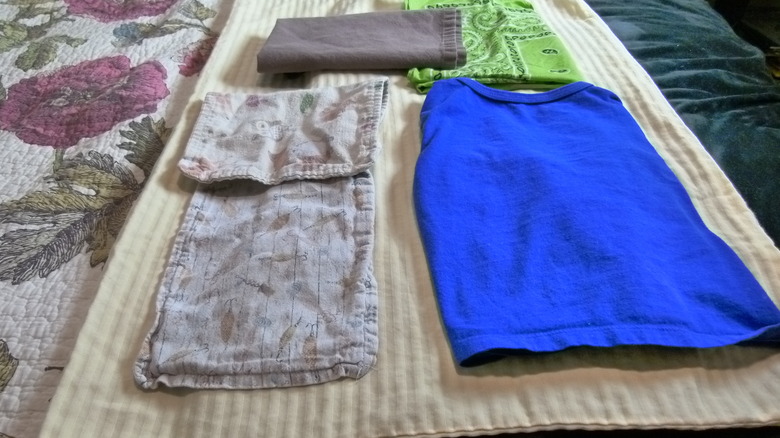We De-Wrinkled Our Clothes With A Wet Rag & Now We're Feeling Smooth
The heat and steam in your dryer keep your clothing looking freshly pressed ... but only if you get everything out promptly when it buzzes and immediately fold or hang everything before the entropy of the laundry pile makes everything all wrinkly again. Otherwise, steam must be used to straighten out our wrinkly skirts and shirts a second time. However unpleasant this news is, it's not new, given that most clothing irons are steam irons. Unfortunately, they're also irons. Luckily, there are plenty of hacks to meet consumers' strong desire to avoid irons. For persistently wrinkly fabrics, we've seen steam-centric suggestions like wielding a hair dryer at damp clothes, tossing an ice cube in the dryer, and even taking your clothes into a hot shower. Dependable Cleaners recommends simply throwing the dry, wrinkled items back into a dryer with a damp bit of cloth ... something similar in size to a cloth napkin, handkerchief, sock, or washcloth. That sounds promising.
Steaming laundry works to remove wrinkles, according to Conair (who makes both hand-held steamers and traditional steam irons), because steam penetrates fabric's fibers and relaxes them. Ironing Supplies echoes this claim, adding detail without much clarity: "When the steam penetrates the fibre's [sic] of the fabric, it adds moisture to the material, which helps to loosen the bonds between the fibres." We haven't found a clear explanation of the phenomenon. But the damp cloth trick might work, even without our understanding of it, so we decided to test it ourselves.
Setting up our wet cloth test
Our idea was simple: We would start by assembling two sets of laundry that are wrinkled in about equal, and marked, ways. We tried to include very similar items in both sets to avoid inadvertently skewing the results. These included pillowcases, homemade wipes (the sorts of things that accompany cloth diapering), some kids' shirts, and other articles. One set of items would be dried for 15 minutes on the Quick Dry setting with no moisture present. The second set would be dried for the same time on the same setting but with a damp cloth napkin thrown in to bring the steam.
All of this was to be done using a Whirlpool Duet Steam electric dryer, without the steam function, of course. We cleaned the lint trap before each use. Our choice of the Quick Dry setting came about as a result of several factors. Its default 15-minute cycle is a pretty common timeframe for a wrinkle-release dryer load, and the dryer operates at medium temperature during the cycle ... not high heat, but certainly hot enough to get things steamy in 15 minutes. The Quick Dry cycle is also recommended for small loads.
Going to great lengths to avoid ironing
For our damp cloth, we used a cloth napkin rather than a sock or handkerchief (do people still use handkerchiefs)? For a larger load, a washcloth or a bit of chamois would probably hold a bit more water. It might also have made sense to actually iron a set of the laundered items as another sort of control group. Yeah, good one. When one is putting all of this effort into avoiding ironing, one does not simply walk in with an iron.
Precisely when the 15-minute cycle was complete, we removed the items and carried them gently to the nearest bedroom. Everything was immediately laid out flat and smoothed quickly, exactly once, by hand. We photographed a few of the items throughout this process as documentation and reminders, and just in case our little competition seemed too close to call ... but it really wasn't, though it was a little closer than we would have guessed based on the industry's apparent obsession with steam.
Steamed-flat living is a big shrug
Jersey knit fabrics like t-shirts fared best when exposed to steam. Drying without moisture made only a slight difference to these fabrics, but the steamed shirts came out nearly perfect. Relatively high-thread-count pillowcases tried to hold onto their wrinkles, and the damp napkin made only a slight difference. The coarser weave of the reusable wipes didn't appear much different at first. Some aspect of the edge stitching had contracted over the course of many launderings, and the wipes are wavy on their best days, but the steamed wipes were a bit smoother.
The 15 minutes was sufficient to completely dry the wet napkin, which exited the dryer looking almost ironed. And this raises a question to which we don't know the answer ... but we can guess. If laundry is dried on a cycle capable of removing the water from the fabric, presumably in the form of steam, what work is being done by a later refresh-and-wrinkle-release cycle with a damp cloth? It seems reasonable to assume that the items, removed promptly and folded or hung immediately after drying, would be at their best. We wouldn't bother adding the step to a load of laundry in its fresh-from-the-dryer state, which might not improve much. But if the steamed refresh is just a way of smoothing laundry that wasn't put away quickly or otherwise managed to get wrinkled, that seems a good use of the trick, which does appear to work pretty well.



